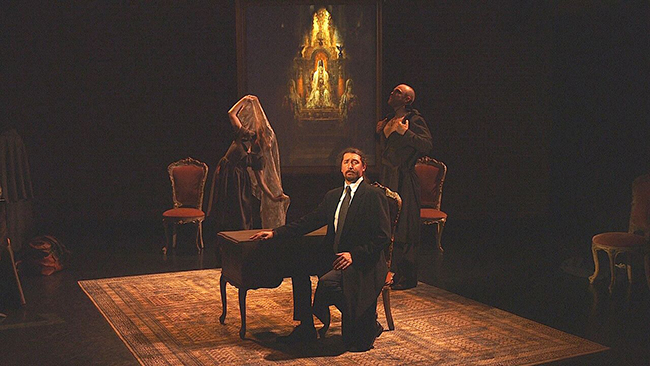Against Nature

Against Nature
Director and choreographer: James Kudelka
Performers: Alexander Dobson, Laurence Lemieux and Geoffrey Sirett
May 5-15, 2016
Mimi Herrndorf Studio, The Citadel, Toronto
Reviewed by Ted Fox
The Coleman Lemieux & Compagnie music-dance-opera theatre production of Against Nature (A rebours) is based on French writer Joris-Karl Huysmans' novel of the same name, written in 1884. It explores the life of eccentric Jean des des Esceintes (referred to in this work as The Master) who abhors the nineteenth century and leaves his life of Parisian decadence to retreat into the isolation of his country house in Fontenay.
He lives with two servants (dancer Laurence Lemieux and Baritone Geoffrey Sirett).
They interact with their master (Bass-Baritone Alexander Dobson), commenting like a Greek chorus on his decadent past, his deteriorating health and his current actions and state of mind.
They morph from being servants from time to time, moving the few props when necessary and interpreting other characters. Lemieux has a striking moment when she morphs into a tortoise onto whose shell the master has set gemstones, their heaviness causing its death. In another sequence, she incarnates Salome and does the famous veil dance. She and Sirett at one point dance in a pushing, pulling, twirling duet, in which they waltz like mechanical dolls, then exhausted, lie side by side, splayed out like marionnettes with no Master operating their strings.
Director and choreographer James Kudelka uses his dance background to bring out subtle nuances in Dobson's singing of Alex Poch-Golden's libretto and his own movement vocabulary. Dobson articulates, pauses, and elongates vowels. His body language is triggered by his conjuring up of past memories, and the effects of the Jesuit educuation, sufferings and sexual decadence embedded in his body. It's marvellous to see the many shades of emotions, varying from humorous to dark, crossing over his face. How he sniffs a vial of perfume or registers his bliss as he holds a favorite book is just magical. His interpretation is also influenced by the striking claustrophobic set design and the lighting that conveys a feeling of melancholia.
At the back of the stage is a large portrait of The Master, enclosed within a framed screen, with projection design by Jeremy Mimnagh. As we enter, this portrait looms, one eye lit in an observing stare. Gradually, the image on the screen transforms into birds, a leafless tree, art objects, flowers, his library-- until all becomes more and more abstract and ends with a stark figure, "his face is like clay, lips bloated and dry." We last see The Master on the verge of going back to civilization, where he muses:
"The nobility is dead
Aristocracy is finished
Is there left one man who values
The meaning of a phrase,
The gesture in a painting,
The pattern of his days."
The live music features a trio of three muscians: Steven Philcox (piano), Parmela Attariwal (violin) and Caruba Reenes (cello). Composer James Rolfe has used throughout a repetitious playful motif relevant to the resurgence of the Master's memories. For me, the score also has a music hall theme in it. All this while at the same time fully suggesting the mental stress and discomfort experienced by The Master, torn by living a life of isolation in which he is constantly assaulted by the past, and returning to a civiilization he detests
Dance, music, text and theatre were perfectly integrated, resulting in a beautiful hypnotic work, heightened by the intimacy of the performers with the audience within the small theatre in The Citadel.

